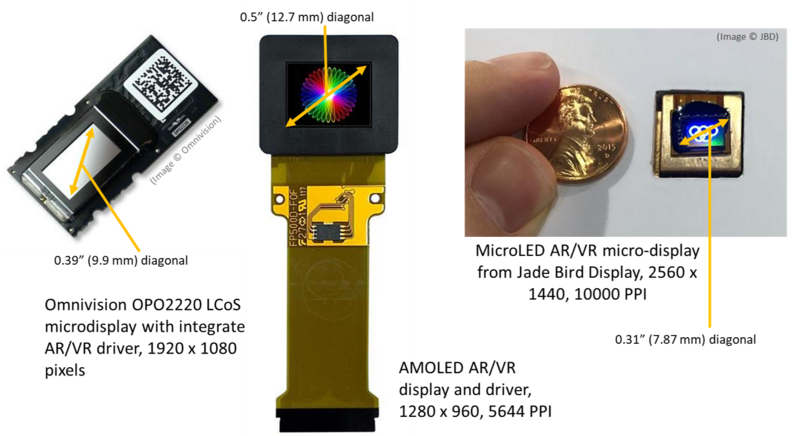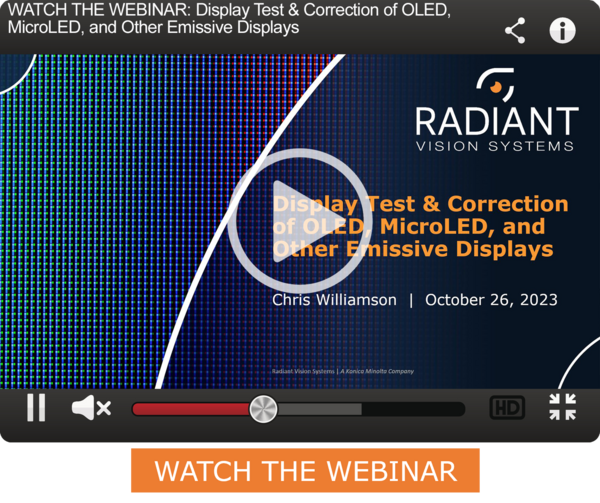The Future of AR/VR is Micro: Microdisplays, MicroLED, and MicroOLED
New industry trends and reports are pointing to a future of autmented and virtual reality devices (AR/VR/MR, collectively XR) that rely heavily on microLED and microOLED display technolgies. Many of these devices already use microdisplays (generally defined as a screen that measures less than 2" diagonal), adding to the proliferation of "micro" elements.

Examples of current XR microdisplays.
To provide a high-quality visual user experience in XR headsets, the size and performance characteristics of microLED and microOLED are an attractive option for hardware designers. In AR/VR systems, a key specification is pixels per degree (PPD), which is a factor of display resolution and field of view (FOV). If PPD isn't high enough, images may not have sufficient clarity, or issues like the screen door effect may occur. MicroLED and microOLED disaplays with their tiny, densely packed pixels can ensure high PPD, safisfying various requirements of VR vs AR devices:1
| VR (and pass-through AR) | See-through AR |
|---|---|
| Mostly based on TFT LCD and AMOLED | All headsets: microdisplays (DLP, Micro-LCD, LCoS, MicroOLED) or laser beam scanner (LBS) |
| MicroOLED has been introduced, offering high brightness, high PPD/high resolution, high fill factor, efficiency and longer lifetime | MicroLED is entering the market, offering very high brightness, ultra-compact form factor, energy efficiency and reliability |
| Needs high pixel density (PPD) to reduce screen door effect | Needs high resolution, very high brightness displays, glass-like design, small-size (thinner and lighter) and power efficiency |
| Requires high refresh rates and a short duty cycle to reduce motion sickness | The basic configuration includes a display unit, magnifying optics, and a combiner |
| Needs smaller, lighter headsets |
The differences between VR, AR, and MR devices point to additional reasons that microOLED and microLED technologies can be advantageous for XR. For example, microLEDs typically provide higher brightness (luminance), as needed for see-through AR where images are presented to the wearer overlaid on the background environment. Images and characters need to have sufficient brightness and contrast to be visible even in daylight ambient lighting.
Micro Elements Pose Major Quality Challenges
However, when it comes to all of these micro-sized items, traditional display inspection techniques are no longer sufficient. Unlike LCD displays that rely on a backlight, microLED and microOLEDs are individual emitters: each LED is its own pixel driven individually to emit its own light. This means microLEDs/microOLEDs can exhibit wider variation in birghtness and color from one pixel—or subpixel—to the next.
Defects and a lack of uniformity (called mura) need to be identified and measured accurately during the manufacturing process, which then enables a correction factor to be applied. The correction process, called demura, helps improve the quality of a device display so that it meets brand standards and can be sold instead of discarded. Inspecting high-PPD, high-resolution microdisplays displays down to the subpixel level requires very high-resolution measurement systems, such as Radiant's ProMetric® imaging photometers and colorimeters with sensors up to 61 MP.

A microLED display shown before (left) and after (right) demura measurement and correction with a ProMetric imager and TrueTest™ software. Image courtesy of Jasper Display.
Learn more about emissive displays such as OLED, microLED and microOLED and methods for effective measurement and correction in the webinar, "Display Test & Correction of OLED, MicroLED, and Other Emissive Displays." Hosted by Consumer Electronics Test and Development and presented by Radiant's Chris Williamson, the webinar is available on demand (with free registration). See how companies in AR/VR and the consumer device industry maintain the quality of their display products.

CITATIONS
1. Dash, S., "MicroOLED and MicroLED: The Future of AR/VR Displays," Display Daily, October 31, 2023.
Join Mailing List
Stay up to date on our latest products, blog content, and events.
Join our Mailing List
